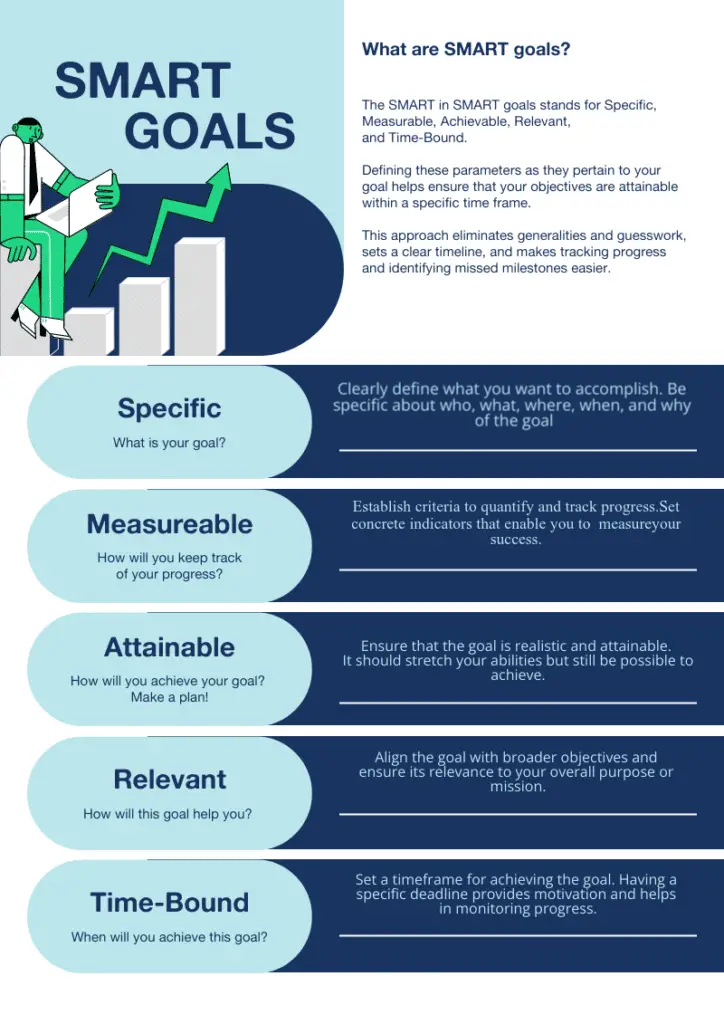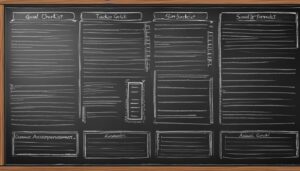
Smart goals can be a great resource for a nursing student and nursing career. The best way to excel in this career path is the use of smart goals. Fellow nurses seek new ways to increase continuous improvement in their careers.
Understanding the SMART framework created an action plan for nurse practitioners. The importance of goal setting is to always want improvement in career goals and personal life. Smart nursing goals should include clinical rotations, gaining assessment skills, and a plan of care.
Using the SMART method is a great way to set goals and most professionals use this framework. As soon as you begin using this framework, your team members will see a sense of urgency in you. But all you did was plan using specific goals, measurable goals, attainable goal, relevant goals, and a set time frame framework to give the best patient care.
What are SMART Goals for Nurses
Setting goals is an evolutionary part of a future career as a nurse. Using SMART goals is a smart way to plan your path to success.
By adopting the SMART approach in goal-setting, you establish a framework that ensures consistent goal achievement, paving the way for success. This method equips you with the resources to transform your aspirations from mere visions into tangible, actionable steps that you can actively pursue each day.
Nursing Definition
Nursing includes the promotion of health, prevention of illness, and the care of ill, disabled and dying people.
International Council of Nursing
Diving Deeper into Smart Goals

SMART goal is an abbreviation representing five characteristics that enhance the predictability and comprehensiveness of a goal.
- Specific: Clearly define what you want to accomplish. Be specific about The Who, what, where, when, and why of the goal.
- Measurable: Establish concrete criteria for measuring progress toward the goal.
- Attainable: Ensure that the goal is realistic and attainable. It should stretch you but still be possible to achieve.
- Relevant: Make sure the goal is relevant and aligned with your broader objectives. It should matter and contribute to your overall success.
- Time-bound: Set a deadline for when the goal should be achieved. Having a timeframe creates a sense of urgency and helps in managing your time effectively.
Now that you understand the SMART framework here are the smart goal examples for nursing.
33 Examples of Smart Goals for Nurses
1. Increase Patient Satisfaction:
Increase patient satisfaction scores by 15% within the next six months by implementing enhanced communication strategies and improving responsiveness among other nurses.
SMART Goal Example
– Specific (S): Increase patient satisfaction scores.
– Measurable (M): Achieve a 15% improvement in scores.
– Achievable (A): Implement enhanced communication and responsiveness strategies.
– Relevant (R): Enhance patient satisfaction through improved interactions.
– Time-bound (T): Achieve the goal within the next six months.
2. Attend Two Professional Development Workshops:
Attend two professional development workshops within the next year to enhance clinical skills and broaden knowledge as nurses
– Specific (S): Attend two professional development workshops.
– Measurable (M): Complete both workshops.
– Achievable (A): Identify and register for relevant workshops.
– Relevant (R): Enhance clinical skills and knowledge.
– Time-bound (T): Complete the goal within the next year.

3. Reduce Medication Errors:
Reduce medication errors by 20% within the next quarter by implementing and reinforcing enhanced double-check protocols for medication administration.
SMART Goal Example
– Specific (S): Reduce medication errors by 20%.
– Measurable (M): Track and document the reduction in errors.
– Achievable (A): Implement improved double-check protocols.
– Relevant (R): Enhance patient safety through error reduction.
– Time-bound (T): Achieve the goal within the next quarter.
4. Increase Compliance Rate:
Achieve a 95% compliance rate with hand hygiene protocols within the next three months through consistent monitoring, staff training, and reinforcement of proper hand hygiene practices.
– Specific (S): Attain a 95% compliance rate with hand hygiene protocols.
– Measurable (M): Monitor and document hand hygiene compliance regularly.
– Achievable (A): Implement staff training and reinforcement strategies.
– Relevant (R): Improve infection control and overall patient safety.
– Time-bound (T): Achieve the goal within the next three months
5. Complete a Certification:
Complete certification in a specialized nursing field within the next 12 months to broaden your expertise and enhance your professional qualifications.
SMART Goal Example
– Specific (S): Obtain certification in a specialized nursing field.
– Measurable (M): Complete the certification requirements.
– Achievable (A): Identify and enroll in a recognized certification program.
– Relevant (R): Expand expertise and advance professional qualifications.
– Time-bound (T): Achieve certification within the next 12 months

6. Increase Patient Education:
Increase the number of patient education sessions conducted by 25% within the next six months by implementing a structured scheduling system, improving promotional efforts, and collaborating with relevant healthcare nurses.
SMART Goal Example
– Specific (S): Boost the number of patient education sessions by 25%.
– Measurable (M): Monitor and quantify the increase in conducted sessions.
– Achievable (A): Implement a structured scheduling system and enhance promotional strategies.
– Relevant (R): Improve patient understanding and engagement in healthcare.
– Time-bound (T): Achieve the goal within the next six months.
7. Implement a New Triage System:
Implement a new triage system within the next four months to decrease patient waiting times by 30%, utilizing efficient protocols and staff training.
– Specific (S): Introduce a new triage system to reduce patient waiting times.
– Measurable (M): Track and measure the reduction, ensuring a 30% improvement.
– Achievable (A): Develop and implement an efficient triage protocol and provide staff training.
– Relevant (R): Enhance patient satisfaction by decreasing waiting times.
– Time-bound (T): Achieve the goal within the next four months.
8. Participate in Two Improvement Projects:
Participate in a minimum of two quality improvement projects within the next year to elevate patient care, contributing to measurable enhancements in healthcare delivery.
SMART Goal Example
– Specific (S): Engage in two quality improvement projects.
– Measurable (M): Demonstrate measurable improvements in patient care.
– Achievable (A): Identify and commit to relevant quality improvement initiatives.
– Relevant (R): Enhance the quality of patient care through active involvement in improvement projects.
– Time-bound (T): Complete participation in two projects within the next year.
9. Enhance Team Collaboration:
Enhance team collaboration by initiating and leading bi-monthly interdisciplinary meetings within the next six months, fostering open communication and shared decision-making.
– Specific (S): Initiate and lead bi-monthly interdisciplinary meetings.
– Measurable (M): Observe improvements in team collaboration through increased communication and shared decision-making.
– Achievable (A): Establish a schedule for regular meetings and create a conducive environment for open discussions.
– Relevant (R): Strengthen team collaboration and overall effectiveness.
– Time-bound (T): Implement and lead meetings within the next six months.
10. Improve Personal Knowledge:
Enhance personal knowledge of evidence-based practice by reviewing and incorporating one new study per month into professional activities within the next year.
SMART Goal Example
– Specific (S): Review and incorporate one new study per month.
– Measurable (M): Track the number of studies reviewed and integrated into professional activities.
– Achievable (A): Allocate time each month for study review and application.
– Relevant (R): Stay current with evidence-based practices to improve decision-making.
– Time-bound (T): Complete the goal within the next year
11. Decrease Patient Readmission:
Decrease patient readmission rates by 10% within the next six months by implementing improved discharge planning processes and enhancing follow-up procedures.
SMART Goal Example
– Specific (S): Reduce patient readmission rates by 10%.
– Measurable (M): Monitor and quantify the reduction in readmission rates.
– Achievable (A): Implement enhanced discharge planning and follow-up protocols.
– Relevant (R): Improve patient outcomes and satisfaction while optimizing healthcare resources.
– Time-bound (T): Achieve the goal within the next six months.
12. Participate in Leadership Training:
Participate in leadership training within the next two years to develop management skills to prepare for and potentially pursue a leadership role.
SMART Goal Example
– Specific (S): Attend leadership training for skill development.
– Measurable (M): Acquire and enhance management skills through training.
– Achievable (A): Enroll in a recognized leadership program or workshop.
– Relevant (R): Prepare for potential leadership responsibilities.
– Time-bound (T): Complete leadership training within the next two years.

13. Improve Cultural Competence:
Improve cultural competence by actively participating in diversity and inclusion training sessions within the next quarter, fostering a more inclusive and culturally sensitive work environment.
SMART Goal Example
– Specific (S): Participate in diversity and inclusion training sessions.
– Measurable (M): Assess personal growth in cultural competence through feedback and self-reflection.
– Achievable (A): Attend relevant training sessions provided by reputable sources.
– Relevant (R): Promote a more inclusive and culturally sensitive work environment.
– Time-bound (T): Complete the training sessions within the next quarter.
14. Launch a Nurse Mentoring Program:
Implement a nurse mentoring program within the next six months to enhance new nurse retention rates, fostering a supportive environment for skill development and job satisfaction.
SMART Goal Example
– Specific (S): Establish and launch a nurse mentoring program.
– Measurable (M): Measure the impact on new nurse retention rates.
– Achievable (A): Develop program guidelines and resources for effective mentoring.
– Relevant (R): Improve job satisfaction and support the professional growth of new nurses.
– Time-bound (T): Launch the mentoring program within the next six months.
15. Attain 100% Compliance Rate:
Attain a 100% compliance rate with infection control policies within the next three months by implementing rigorous monitoring, staff training, and reinforcing adherence to established protocols.
– Specific (S): Achieve full compliance with infection control policies.
– Measurable (M): Monitor and measure adherence, aiming for 100% compliance.
– Achievable (A): Implement monitoring mechanisms and staff training to ensure understanding and compliance.
– Relevant (R): Enhance infection prevention and maintain a safe healthcare environment.
– Time-bound (T): Achieve the goal within the next three months.
16. Implement a Wellness Program:
Develop and implement a comprehensive wellness program for nursing staff within the next six months, aiming to enhance job satisfaction and alleviate burnout through engaging activities and supportive resources.
– Specific (S): Establish and roll out a wellness program tailored for nursing staff.
– Measurable (M): Monitor participation rates and gauge improvements in job satisfaction and burnout levels.
– Achievable (A): Develop a feasible program with activities and resources that cater to the specific needs of nursing staff.
– Relevant (R): Improve overall well-being, and job satisfaction, and reduce burnout among nursing staff.
– Time-bound (T): Launch the wellness program within the next six months.
17. Enhance Interdisciplinary Communication:
Enhance interdisciplinary communication by initiating regular case review meetings with other healthcare professionals within the next three months, promoting collaboration, and improving patient care.
SMART Goal Example
– Specific (S): Initiate regular case review meetings with healthcare professionals from various disciplines.
– Measurable (M): Assess improvements in communication through feedback and observable changes in collaboration.
– Achievable (A): Establish a schedule and framework for case review meetings that accommodate diverse healthcare professionals.
– Relevant (R): Enhance patient care outcomes through improved interdisciplinary communication.
– Time-bound (T): Commence regular case review meetings within the next three months.

18. Take Advanced Life Support Cert:
Complete an advanced life support certification within the next six months by enrolling in a recognized program, attending all required training sessions, and passing the certification examination.
SMART Goal Example
– Specific (S): Obtain advanced life support certification.
– Measurable (M): Complete all required training and pass the certification examination.
– Achievable (A): Enroll in a reputable advanced life support certification program.
– Relevant (R): Enhance professional qualifications and improve emergency response skills.
– Time-bound (T): Achieve certification within the next six months.
19. Improve Patient Safety:
Enhance patient safety by initiating and actively participating in regular mock code blue scenarios within the next three months, ensuring effective emergency response and promoting a culture of preparedness.
SMART Goal Example
– Specific (S): Conduct and participate in regular mock code blue scenarios.
– Measurable (M): Assess improvements in emergency response through feedback and performance evaluations.
– Achievable (A): Establish a schedule and framework for conducting regular mock code blue scenarios.
– Relevant (R): Improve patient safety by enhancing team readiness for emergencies.
– Time-bound (T): Begin conducting and participating in mock code blue scenarios within the next three months.
20. Decrease Patient Falls:
Decrease patient falls by 15% within the next six months through the implementation of personalized fall prevention plans, involving comprehensive risk assessments, tailored interventions, and continuous monitoring.
SMART Goal Example
– Specific (S): Implement personalized fall prevention plans for all at-risk patients.
– Measurable (M): Track and measure a 15% reduction in patient falls.
– Achievable (A): Develop and apply individualized fall prevention strategies based on comprehensive risk assessments.
– Relevant (R): Improve patient safety by addressing fall risks proactively.
– Time-bound (T): Achieve a 15% reduction in patient falls within the next six months.
21. Expand Patient Education:
Expand patient education resources by creating and distributing new materials on common health topics within the next four months, increasing the accessibility and variety of educational content for patients.
SMART Goal Example
– Specific (S): Develop and distribute new patient education materials on common health topics.
– Measurable (M): Increase the number of available patient education materials.
– Achievable (A): Create informative and engaging materials covering a range of common health topics.
– Relevant (R): Enhance patient understanding and promote proactive healthcare engagement.
– Time-bound (T): Complete the development and distribution of new materials within the next four months.

22. Implement a New Electronic Record System:
Collaborate with the IT department to successfully implement a new electronic health record system within the next nine months, enhancing operational efficiency and streamlining healthcare processes.
SMART Goal Example
– Specific (S): Work with the IT department to implement a new electronic health record system.
– Measurable (M): Gauge improvements in efficiency through reduced processing times and enhanced data management.
– Achievable (A): Collaborate closely with the IT team to plan, develop, and execute the implementation.
– Relevant (R): Improve operational efficiency by transitioning to a more effective electronic health record system.
– Time-bound (T): Complete the implementation of the new system within the next nine months.
23. Improve Communication Skills:
Improve communication skills by actively participating in a therapeutic communication workshop within the next three months, and acquiring practical techniques to enhance interactions with patients and colleagues.
SMART Goal Example
– Specific (S): Attend a therapeutic communication workshop.
– Measurable (M): Apply learned communication techniques in professional interactions.
– Achievable (A): Enroll in a recognized therapeutic communication workshop.
– Relevant (R): Enhance communication skills for more effective patient and colleague interactions.
– Time-bound (T): Attend and complete the therapeutic communication workshop within the next three months.
24. Reduce Overtime Hours:
Reduce overtime hours by 10% within the next six months through the implementation of enhanced shift scheduling and staffing management practices, ensuring efficient allocation of resources and maintaining optimal staffing levels.
SMART Goal Example
– Specific (S): Decrease overtime hours by 10% through improved shift scheduling and staffing management.
– Measurable (M): Track and measure the reduction in overtime hours.
– Achievable (A): Implement effective scheduling and staffing management strategies.
– Relevant (R): Improve resource allocation and optimize staffing levels.
– Time-bound (T): Achieve a 10% reduction in overtime hours within the next six months.
25. Enhance Wound Care :
Enhance wound care proficiency by completing a specialized wound care training program within the next six months, and acquiring advanced skills and knowledge in wound management.
SMART Goal Example
– Specific (S): Complete a specialized wound care training program.
– Measurable (M): Demonstrate proficiency in wound care through assessments and practical application.
– Achievable (A): Enroll in a reputable wound care training program.
– Relevant (R): Improve skills and knowledge in advanced wound management.
– Time-bound (T): Complete the specialized wound care training program within the next six months.
26. Enhance Medication Administration:
Enhance the accuracy of medication administration by implementing barcode scanning technology within the next quarter, ensuring a systematic and error-reducing approach to medication management.
SMART Goal Example
– Specific (S): Implement barcode scanning technology for medication administration.
– Measurable (M): Evaluate and measure the increase in accuracy through reduced medication errors.
– Achievable (A): Integrate barcode scanning technology into the medication administration process.
– Relevant (R): Improve patient safety by minimizing medication administration errors.
– Time-bound (T): Complete the implementation of barcode scanning technology within the next quarter.
27 Engage in Community Health Outreach:
Engage in a minimum of two community health outreach programs within the next year, actively contributing to the promotion of health and well-being in the local community.
SMART Goal Example
– Specific (S): Participate in two community health outreach programs.
– Measurable (M): Attend and actively contribute to both programs.
– Achievable (A): Identify and commit to relevant community health outreach initiatives.
– Relevant (R): Contribute to community health improvement efforts.
– Time-bound (T): Complete participation in two programs within the next year.

28. Improve Patient Response Time:
Develop and implement a process for a timely response to patient call lights, aiming to achieve a 90% response rate within the next three months, ensuring prompt and efficient attention to patient needs.
SMART Goal Example
– Specific (S): Establish and execute a process for timely response to patient call lights.
– Measurable (M): Track and measure response rates, aiming for a 90% success rate.
– Achievable (A): Implement effective procedures to enhance response times.
– Relevant (R): Improve patient satisfaction by addressing call lights promptly.
– Time-bound (T): Achieve a 90% response rate within the next three months.
29. Improve Interdisciplinary Teamwork:
Improve interdisciplinary teamwork by organizing and actively participating in regular team-building activities within the next four months, fostering collaboration and strengthening relationships among team members.
SMART Goal Example
– Specific (S): Organize and participate in team-building activities.
– Measurable (M): Assess improvements in teamwork through feedback and observable changes in team dynamics.
– Achievable (A): Plan and execute team-building activities that cater to the needs of the interdisciplinary team.
– Relevant (R): Enhance collaborative efforts and strengthen relationships within the team.
– Time-bound (T): Conduct regular team-building activities within the next four months.
30. Implement Mandatory Training:
Attain a 90% compliance rate with mandatory training requirements for nursing staff within the next six months by implementing streamlined training processes, providing accessible resources, and closely monitoring completion rates.
SMART Goal Example
– Specific (S): Achieve a 90% compliance rate with mandatory training for nursing staff.
– Measurable (M): Track and measure the completion rates of mandatory training sessions.
– Achievable (A): Implement efficient training processes and provide accessible resources.
– Relevant (R): Ensure that nursing staff are well-informed and up-to-date with required training.
– Time-bound (T): Achieve a 90% compliance rate within the next six months.
31. Implement Stress Management:
Implement a stress management program for nursing staff within the next three months to enhance overall well-being, incorporating evidence-based strategies and regularly assessing participation and feedback.
SMART Goal Example
– Specific (S): Introduce a stress management program for nursing staff.
– Measurable (M): Assess participation rates and gather feedback to measure program effectiveness.
– Achievable (A): Develop and implement a comprehensive stress management program.
– Relevant (R): Improve overall well-being and resilience among nursing staff.
– Time-bound (T): Launch and commence the stress management program within the next three months.
32. Enhance Documentation Accuracy:
Enhance documentation accuracy by conducting monthly chart audits and providing constructive feedback to the team within the next six months, fostering a culture of continuous improvement in documentation practices.
SMART Goal Example
– Specific (S): Conduct monthly chart audits to assess and improve documentation accuracy.
– Measurable (M): Track improvements in documentation accuracy based on audit findings.
– Achievable (A): Establish a systematic process for conducting chart audits and delivering feedback.
– Relevant (R): Enhance the accuracy and reliability of patient documentation.
– Time-bound (T): Complete monthly chart audits and provide feedback within the next six months.

33. Lead Quality Improvement Projects:
Initiate and lead a quality improvement project focused on reducing hospital-acquired infections within the next year by developing and implementing evidence-based interventions, monitoring outcomes, and collaborating with relevant stakeholders.
SMART Goal Example
– Specific (S): Launch and lead a quality improvement project targeting hospital-acquired infections.
– Measurable (M): Track and measure the reduction in hospital-acquired infections.
– Achievable (A): Develop and implement evidence-based interventions in collaboration with the healthcare team.
– Relevant (R): Improve patient safety and reduce the incidence of hospital-acquired infections.
– Time-bound (T): Initiate and lead the quality improvement project within the next year.




